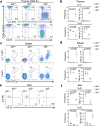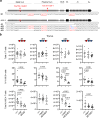E proteins control the development of NKγδT cells through their invariant T cell receptor
- PMID: 38871720
- PMCID: PMC11176164
- DOI: 10.1038/s41467-024-49496-3
E proteins control the development of NKγδT cells through their invariant T cell receptor
Abstract
T cell receptor (TCR) signaling regulates important developmental transitions, partly through induction of the E protein antagonist, Id3. Although normal γδ T cell development depends on Id3, Id3 deficiency produces different phenotypes in distinct γδ T cell subsets. Here, we show that Id3 deficiency impairs development of the Vγ3+ subset, while markedly enhancing development of NKγδT cells expressing the invariant Vγ1Vδ6.3 TCR. These effects result from Id3 regulating both the generation of the Vγ1Vδ6.3 TCR and its capacity to support development. Indeed, the Trav15 segment, which encodes the Vδ6.3 TCR subunit, is directly bound by E proteins that control its expression. Once expressed, the Vγ1Vδ6.3 TCR specifies the innate-like NKγδT cell fate, even in progenitors beyond the normally permissive perinatal window, and this is enhanced by Id3-deficiency. These data indicate that the paradoxical behavior of NKγδT cells in Id3-deficient mice is determined by its stereotypic Vγ1Vδ6.3 TCR complex.
© 2024. The Author(s).
Conflict of interest statement
The authors declare no competing interests.
Figures







Similar articles
-
Id3 and Id2 act as a dual safety mechanism in regulating the development and population size of innate-like γδ T cells.J Immunol. 2014 Feb 1;192(3):1055-1063. doi: 10.4049/jimmunol.1302694. Epub 2013 Dec 30. J Immunol. 2014. PMID: 24379125 Free PMC article.
-
Inhibitor of DNA binding 3 limits development of murine slam-associated adaptor protein-dependent "innate" gammadelta T cells.PLoS One. 2010 Feb 19;5(2):e9303. doi: 10.1371/journal.pone.0009303. PLoS One. 2010. PMID: 20174563 Free PMC article.
-
Marked induction of the helix-loop-helix protein Id3 promotes the gammadelta T cell fate and renders their functional maturation Notch independent.Immunity. 2009 Oct 16;31(4):565-75. doi: 10.1016/j.immuni.2009.07.010. Immunity. 2009. PMID: 19833086 Free PMC article.
-
αβ versus γδ fate choice: counting the T-cell lineages at the branch point.Immunol Rev. 2010 Nov;238(1):169-81. doi: 10.1111/j.1600-065X.2010.00947.x. Immunol Rev. 2010. PMID: 20969592 Free PMC article. Review.
-
Shifting gears: Id3 enables recruitment of E proteins to new targets during T cell development and differentiation.Front Immunol. 2022 Aug 2;13:956156. doi: 10.3389/fimmu.2022.956156. eCollection 2022. Front Immunol. 2022. PMID: 35983064 Free PMC article. Review.
Cited by
-
T Cell Development: From T-Lineage Specification to Intrathymic Maturation.Adv Exp Med Biol. 2025;1471:81-137. doi: 10.1007/978-3-031-77921-3_4. Adv Exp Med Biol. 2025. PMID: 40067585 Review.
-
Interlinked roles for HEB and Id3 in fetal gamma-delta T cell commitment and functional programming.bioRxiv [Preprint]. 2025 Jun 8:2025.06.08.658490. doi: 10.1101/2025.06.08.658490. bioRxiv. 2025. PMID: 40501861 Free PMC article. Preprint.
References
MeSH terms
Substances
Grants and funding
- P01 AI102853/AI/NIAID NIH HHS/United States
- R01 GM115474/GM/NIGMS NIH HHS/United States
- R35 GM122517/GM/NIGMS NIH HHS/United States
- P30 CA006927/CA/NCI NIH HHS/United States
- P01AI102853/Division of Intramural Research, National Institute of Allergy and Infectious Diseases (Division of Intramural Research of the NIAID)
LinkOut - more resources
Full Text Sources
Molecular Biology Databases

